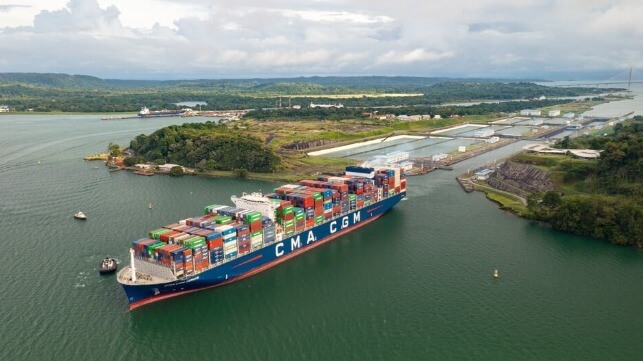Panama Canal Expects Declining Revenues Due to Ongoing Draft Restrictions

The Panama Canal Authority is projecting a significant decline in its income for the year ahead as it works to manage the operations of the vital waterway in the face of a continuing water shortage. This was one of the messages from canal administrator Ricaurte Vasquez during a presentation on Thursday celebrating the role of the Panama Canal and discussing the challenges ahead in the management of the canal.
The canal authority had hoped that July, which is typically the beginning of the rainy season would aid in the water recovery throughout the watershed which consists of the man-made Gatun Lake feed by the Chagres River. They had previously said they would be closely monitoring the development of weather events affecting water availability warning that forecasts had said the arrival of the El Niño phenomenon could worsen the already historically low water levels.
At the end of July, the canal authority said it would defer a further half a foot reduction in the draft limit for ships transiting the canal maintaining a draft of 44 feet during the coming months, as long as weather conditions do not vary significantly from our current projections. This is down from a peak of 50 feet at the beginning of the year.
In part to maintain the draft, the canal however has begun to limit the number of daily transits through both the new and original locks. Previously having handled 34 to 36 ships per day, they are now reducing it to a maximum of 32 ships per day with only 10 daily transits through the larger Neopanamax locks.
During his speech, Vasquez discussed the challenges that the canal faces to maintain its growth. He said as a result of the ongoing restrictions, they are now projecting that the canal’s income in the year could decrease by as much as $200 million. The fiscal year which begins in October had been expected to produce revenues of $4.9 billion for the canal authority.
The limitations on the Neopanamax locks, which were inaugurated seven years ago, are critical as ships grow larger. The new locks account for just over half of the tonnage transiting the canal annually having handled over 20,600 vessels since they opened in June 2016. The authority highlights that it was originally anticipated that the locks would handle vessels with a capacity of 12,600 TEU. They set a record at 16,285 TEU in 2022 and this week Ever Max became the largest capacity containership to transit the Neopanamax locks. The vessel has a nominal capacity of 17,312 TEU, although transited at only three-quarters of capacity.
Maintaining water levels is critical not only for the operational capacity of the canal but also for the availability of fresh water for the consumption of the population. More than 50 percent of the country’s population is supplied fresh water from the watershed that also feeds the canal. Vasquez highlighted the efforts to expand their technological capacity through the integration of larger amounts of hydrometeorological data that he said will make it possible to improve the efficiency and competitiveness of the waterway.
The Panama Canal Authority as part of its planning is also looking at the possibility of developing a logistics corridor that would diversify the ways in which the canal manages cargo across the isthmus. As the draft levels were increased this year, large containerships have already been forced to offload a portion of the boxes for transshipment by train across Panama. The Ever Max, which transited the canal on Tuesday, for example, was required to send 1,400 TEU on the railroad from its total load of 13,345 TEU to meet the draft restrictions. Despite that, the canal authority highlighted that the ship’s transit generated more than $40,000 in revenue.
Among the other issues that Vasquez discussed is the challenge with nearly 2,000 employees close to retirement age. He said the authority needs to attract new skills and young people for its future operation.
